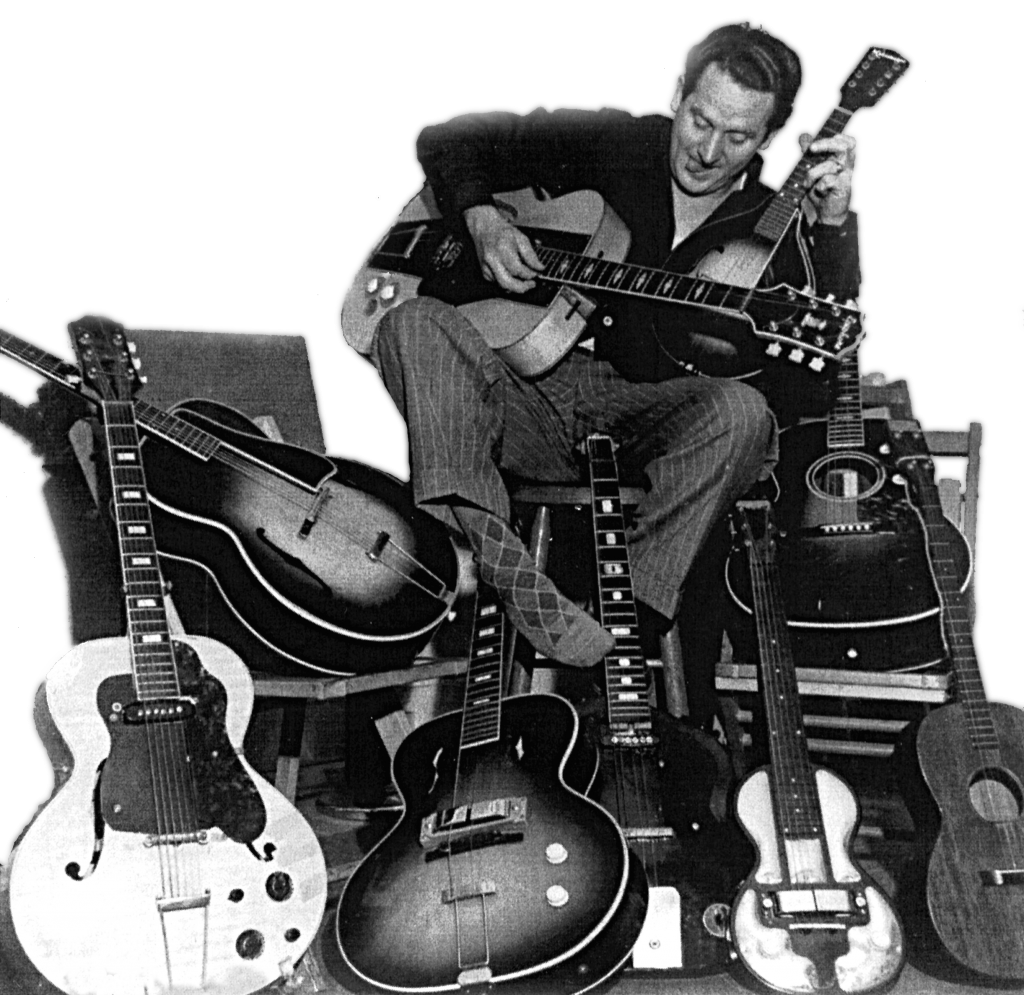From a very early age, it was obvious that young Lester William Polsfuss had a knack for music. But by his mid teens, it became clear that it was more than just a knack; he was virtually a prodigy. Starting around eight years old, young Lester toyed with anything he could get a melodic sound out of, but, after picking up a guitar, his obsession and passion for sound quickly blossomed into a fruitful career that would go down in music history.
Before he was even a teenager, he was making money in tips performing around his hometown of Waukesha, Wisconsin. By 1934, Lester, then in his early teens, had dropped out of high school and was performing in and around Chicago. He had encountered many obstacles of the music electronics of the day.[1. Salem Press Biographical EncyclopediaResearch Starters, 2017, s.v. “Les Paul,” by John R. Holmes.] Guitars were simple and all somewhat similar, and recording music with a full band was a troublesome and repetitive ordeal. He did not intend to be limited by either of these issues. Rather than fall into the repetition of the music industry of his day, he began to set himself apart by experimentation.
Lester’s instrument ideas were at first shot down by large corporations. In 1941, he even brought one of his first solid-body guitar prototypes to Gibson, but the company quickly dismissed him.1 This rejection seemed to motivate him even more, and he returned to the drawing board while his performing career began to culminate.
He despised the fact that his early music sounded so similar to other artists of the day. Because of this, in 1947, Polsfuss started his own recording studio, in which he began utilizing over-dubbing and multitrack recording, which allows one musician to record one instrument at a time and overlay them so that it seems that they are being played at the same time.2 Although it was at first a venture for his own personal music, many musicians flocked to his home studio wanting to be recorded by Lester.
Just as these endeavors were taking off, in 1948, Lester suffered an almost career ending injury, in which his elbow was crushed beyond the point of reconstruction. He made the choice to have his right arm permanently set at less than a 90 degree angle, leaving him the ability to cradle a guitar.3 This action alone is a prime example of the dedication that Polsfuss possessed. Instead of letting his accident end his playing, or let his early failures deter him, he continued to strive to improve and increase the options for creativity that musicians had. He tried again to invent a solid body guitar and new sound recording techniques, all while continuing to work on his own music.
His talent on the guitar gained him so much attention that Gibson, while still unwilling to accept his prototype guitar model, decided to hire him as somewhat of a consultant.4 They wanted his name associated with their product, and they wanted his unmatched innovative mindset. The company created their own solid-body guitar model with the help of Lester, and the name came naturally.5 The Les Paul guitar was created, while Lester came to reach the pinnacle of his fame.

Unwillingness to settle was what set Lester apart from other musicians of the day—his constant need to experiment and create something better or at least different. Rather than just becoming the best he could be at the instruments of the day, he almost seemed more interested in creating new and improved devices to improve his playing. Without this determination, he might have just been another musician in history.
Les Paul, suffering from injury, old age, and arthritis, still continued to play guitar and work with music until his death in August of 2009.3 His lifetime achievements consist of his induction into the Rock and Roll Hall of Fame in 1988, a National Medal of Arts in 2007, multiple Grammys and Emmys, and countless other honors. While his guitar playing styles were an influence to guitarists everywhere, his greatest influences on the music industry were his help in creating a solid body guitar and his creation of over-dubbing and multi-track recording, which have been used by almost every musician since. His name has been immortalized in music history because of his contributions, and any fan or member of the music community has reason to thank him.
- Paul Verna, “‘Just A Pure Genius’: celebrating the legacy of Les Paul, the tinkerer who (really) helped invent rock’n’roll,” Billboard, (2015): 67. ↵
- “The Man Before The Guitar: Remembering Les Paul At 100,” All Things Considered, (June 9, 2015). ↵
- Salem Press Biographical EncyclopediaResearch Starters, 2017, s.v. “Les Paul,” by John R. Holmes. ↵
- “Les Paul and the Electric Guitar,” Innovation Masters: History’s Best Examples of Business Transformation, (2012): 196-199. ↵
- Calen D. Stone, “Paul, Les,” Contemporary Musicians, Vol. 2, (1990): 186-188. ↵
- Salem Press Biographical EncyclopediaResearch Starters, 2017, s.v. “Les Paul,” by John R. Holmes. ↵



52 comments
Maricela Guerra
This was a sad yet intriguing story, I never knew who created the Les Paul. Not to mention I didn’t know about his accidents as well. What struck me, was when it mentioned that he had set his bad arm to a ninety degree angle just so that he can play. This shows his great dedication to the music, and not letting even the biggest obstacles stop you from obtaining your dream.
Thomas Fraire
Coming into this article, I really had no Idea who this was I thought maybe he was like a famous singer or something. Little did I know this man has created some of the most iconic guitars in history, this article was really cool I enjoyed it. It was something unexpected and different I really enjoyed it, great work dude!
Sofia
It is very interesting to see how innovating people think on how to improve any kind of complex instruments. That requires a lot of consistency and creativity, and Les Paul was a determined person and a visionary. It is inspiring to know how he overcame different obstacles such as his elbow injury or big companies rejections and still he became a successful person because he dedicated his life to what he was passionate about.
Isaac Rodriguez
This article was a pleasant read. I enjoyed learning more Gibson’s Les Paul guitar model. I did not know that Lester Polsfuss was the name of the person who created the Les Paul nor did I know of the recording technique he created. I found the article to be uplifting and inspiring, because Polsfuss followed his dream despite the physical injury he faced.
Johnanthony Hernandez
I remember the first time I played a Les Paul and thought to myself, “who was the real Les Paul?” It’s interesting to see how one of my favorite guitars came about and the struggles and persistence that Polfuss. I would never have thought that one of the top selling guitars almost wasn’t and that Les Paul himself continued to play through his injury, age and arthritis until his death.
Andrew Dominguez
This was a very interesting article, since it told the creation of the famous Les Paul guitar. Polsfuss was a prodigy and helped pioneer a new way of recording. I liked even though he suffered a injury that was be on repair he didn’t let this stop him for achieving his dreams. This individual is a role model for never giving up on your dreams. Polsfuss is someone one we should thank since he had inspired many artist with his creations.
Didier Cadena
I was glad to learn about the origin one of the most iconic names in the world of guitars. It was interesting to learn about how he didn’t give up after getting rejected by Gibson and also after injuring his arm. The article highlights the events of Polfuss’ life in an entertaining way. It was also great to read about how innovating he was, and his Les Paul series shows that perfectly.
Carlos Sandoval
I do not know anything about guitars but it had always amazed me how people could play them. I had heard about the different guitars from my father and Les Paul was one of the ones, he had always talked about. It seems like everything great was once rejected and it helped to make them better. I was really intrigued by this article, I love music and always interesting learning about musical history.
Brandon Martinez
Myself owning a Les Paul guitar, I truly did not know the history behind it. The dedication to music by Polsfuss is extraordinary, he spent his whole life trying to create something better, he broke through many barriers some people were scared to touch. Polsfuss’ legacy will never die being that Les Paul guitars are some of the most popular instruments around the world of music, and the amount of hard work and dedication he put into his creation he story will live on in everyone who picks up his guitar.
Samuel Stallcup
Being one of the most iconic guitar designs in music history, its not surprising that Polfuss had such a humble and interesting beginning to his career. His troubled beginnings to do what he couldn’t live without was well highlighted in this article. I feel if it was not for his contributions to music, such as multi-track recording, Polfuss would not have gotten his own guitar. Great article!